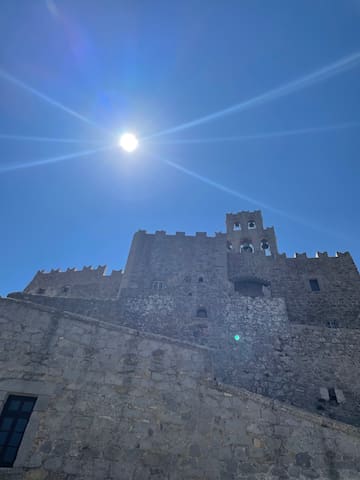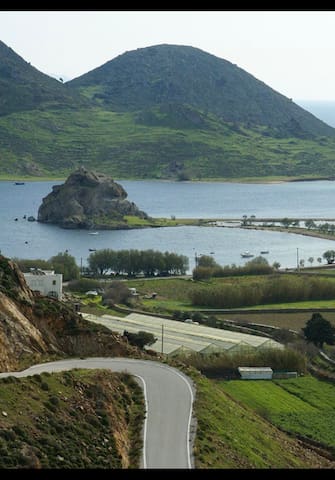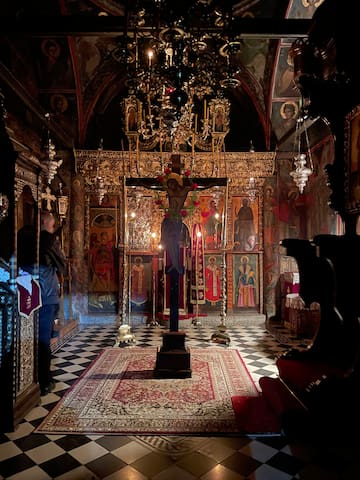Sightseeing
The Monastery of Saint John the Theologian began to be built in 1088 by Saint Christodoulos the Latrinos, who had been granted the whole island of Patmos with a golden bull by the Emperor of Byzantium Alexis the First, Komninos.
He was named Latrinos, because before he went of Patmos he lived on the mountain of Latrous, but due to the Turks he asked the Emperor to grand him the small, desolate and arid island of Patmos, for him to settle there. Some monks and citizens came to live on the island with Saint Christodoulos, who were mainly from Crete and Asia Minor!
The last ones according to the golden bull of Alexis the First, had to be without wives or children! Once the Monastery and the fortress were complete, the need for cultivation arose!
However, as the Saint realized that it would be impossible to ensure permanent inhabitants without families he decided to agree to the settlement of families! In fact he obliged all folk to live away from the Monastery, in the north edge of the island, where monks would not be allowed to go! The borders of the folk area were from Saint Nicolas Evdilos to the area of Vagia!
These people worked and lived in the Monastery five days a week and for the rest of the days they went back to their families! Yet, this solution was also difficult, and in the 12th century a.C., the abbot of the Monastery at the time, forced the farmers and soldiers to live in the Monastery in the summer months, in order to protect it from the pirate attacks, which were beginning during that period!
As a result, in the 13th century, the folk asked to live around the Monastery, so as to be able to be protected but also to protect it at dangerous times! The Monastery belongs to the Ecumenical Patriarchy; it is a Patriarchal exarchate with a Patriarchal exarch, its abbot had special benefits.
The 15-meter tall walls of it gave the image of a fortress, in the middle of the island and during the pirates' attacks the inhabitants were protected behind them.
Above its two and only gates, there was what is called a killer, a type of balcony, from which the inhabitants were able to pour hot oil, to prevent the pirates from entering. The Monastery is built in five levels and its original form of a boat, with its head toward the Ikarian Sea changed, due to certain needs arising for additions and reformations. The cells of the monks are built around the Catholic, according to the Byzantine architecture. Other than that, the building is formed in many different levels and has many of the characteristics of the traditional architecture of the island.
The Monastery has ten chapels, four of which are located in its yard. In the Catholic of the Monastery, there is a temple of unique art, created in 1829, by 12 sculptors. The icons and the frescos in the Catholic are of immense beauty and value.
23 lokal ang nagrerekomenda
Monasteryo ng Saint John the Theologian
The Monastery of Saint John the Theologian began to be built in 1088 by Saint Christodoulos the Latrinos, who had been granted the whole island of Patmos with a golden bull by the Emperor of Byzantium Alexis the First, Komninos.
He was named Latrinos, because before he went of Patmos he lived on the mountain of Latrous, but due to the Turks he asked the Emperor to grand him the small, desolate and arid island of Patmos, for him to settle there. Some monks and citizens came to live on the island with Saint Christodoulos, who were mainly from Crete and Asia Minor!
The last ones according to the golden bull of Alexis the First, had to be without wives or children! Once the Monastery and the fortress were complete, the need for cultivation arose!
However, as the Saint realized that it would be impossible to ensure permanent inhabitants without families he decided to agree to the settlement of families! In fact he obliged all folk to live away from the Monastery, in the north edge of the island, where monks would not be allowed to go! The borders of the folk area were from Saint Nicolas Evdilos to the area of Vagia!
These people worked and lived in the Monastery five days a week and for the rest of the days they went back to their families! Yet, this solution was also difficult, and in the 12th century a.C., the abbot of the Monastery at the time, forced the farmers and soldiers to live in the Monastery in the summer months, in order to protect it from the pirate attacks, which were beginning during that period!
As a result, in the 13th century, the folk asked to live around the Monastery, so as to be able to be protected but also to protect it at dangerous times! The Monastery belongs to the Ecumenical Patriarchy; it is a Patriarchal exarchate with a Patriarchal exarch, its abbot had special benefits.
The 15-meter tall walls of it gave the image of a fortress, in the middle of the island and during the pirates' attacks the inhabitants were protected behind them.
Above its two and only gates, there was what is called a killer, a type of balcony, from which the inhabitants were able to pour hot oil, to prevent the pirates from entering. The Monastery is built in five levels and its original form of a boat, with its head toward the Ikarian Sea changed, due to certain needs arising for additions and reformations. The cells of the monks are built around the Catholic, according to the Byzantine architecture. Other than that, the building is formed in many different levels and has many of the characteristics of the traditional architecture of the island.
The Monastery has ten chapels, four of which are located in its yard. In the Catholic of the Monastery, there is a temple of unique art, created in 1829, by 12 sculptors. The icons and the frescos in the Catholic are of immense beauty and value.
The Holy Cave is located in the middle of the hill between Skala and Chora and it forms the connection between the material and the spirit. As one goes down the 43 steps, he/she passes through the past into the future. In the past, because one senses the presence of saint John the Evangelist, who wrote the Apocalypse in there, and in the future because the book of Apocalypse illustrates and foresees the future. The view from the cave, and the mysticism of the atmosphere are awesome. Saint Christodoulos refurbished the cave when he arrived to Patmos. Today, pilgrims can see the place at which the Apocalypse was written, the place where Saint John stayed, the massive rock that opened up in there and through which God dictated the Apocalypse to Saint John, the point were the Evangelist lay his head to rest and a curve on the rock, which he would hold onto, in order to rise. In order to respond to the need of the pilgrims, the southern part of the cave has been turned into a temple.
17 lokal ang nagrerekomenda
Cave of the Apocalypse
The Holy Cave is located in the middle of the hill between Skala and Chora and it forms the connection between the material and the spirit. As one goes down the 43 steps, he/she passes through the past into the future. In the past, because one senses the presence of saint John the Evangelist, who wrote the Apocalypse in there, and in the future because the book of Apocalypse illustrates and foresees the future. The view from the cave, and the mysticism of the atmosphere are awesome. Saint Christodoulos refurbished the cave when he arrived to Patmos. Today, pilgrims can see the place at which the Apocalypse was written, the place where Saint John stayed, the massive rock that opened up in there and through which God dictated the Apocalypse to Saint John, the point were the Evangelist lay his head to rest and a curve on the rock, which he would hold onto, in order to rise. In order to respond to the need of the pilgrims, the southern part of the cave has been turned into a temple.
After passing Grikos beach, you come across a strange looking rock with a peculiar shape. This is the ever inspirational Rock of Kalikatsou. It's volume and impressive physical presence seems to emerge from the sea. Many hermits chose to live on Kalikatsou, and managed to turn it, by all appearances an unfriendly rock, into a comfortable place, by carving steps, a cistern, a place for coal and candles, leaving their traces on the rock forever! Many stories are connected with the Rock! The mostly widespread traditional story refers to the Monastery of John the Theologian and a hidden door, a crypt that leads to a tunnel. According to this story, the tunnel, crosses the South side of Chora and ends in Petra. It was created so that the monks could carry the Head of The Apostle Thomas and all the other relics and treasures owned by the Monastery, to the bay of Petra and preserve them during the pirate's invasions on the island! This is a must climb for you adventurous types.
Rock of Kalikatsou
After passing Grikos beach, you come across a strange looking rock with a peculiar shape. This is the ever inspirational Rock of Kalikatsou. It's volume and impressive physical presence seems to emerge from the sea. Many hermits chose to live on Kalikatsou, and managed to turn it, by all appearances an unfriendly rock, into a comfortable place, by carving steps, a cistern, a place for coal and candles, leaving their traces on the rock forever! Many stories are connected with the Rock! The mostly widespread traditional story refers to the Monastery of John the Theologian and a hidden door, a crypt that leads to a tunnel. According to this story, the tunnel, crosses the South side of Chora and ends in Petra. It was created so that the monks could carry the Head of The Apostle Thomas and all the other relics and treasures owned by the Monastery, to the bay of Petra and preserve them during the pirate's invasions on the island! This is a must climb for you adventurous types.
The Windmills of the Holy Monastery of Patmos have been declared a Monument of World Heritage by UNESCO and are situated on the top of a hill in Chora. Two were built in 1588 and the third in 1863. When flour production stopped in 1950, the windmills were abandoned and in decline, like most windmills in Europe. In 2010 they were restored with the initiative and founding of Charles Pictet a Swiss Banker and navigator, who is a friend of Patmos and of Niarchos' Institution.
Windmills of Patmos
The Windmills of the Holy Monastery of Patmos have been declared a Monument of World Heritage by UNESCO and are situated on the top of a hill in Chora. Two were built in 1588 and the third in 1863. When flour production stopped in 1950, the windmills were abandoned and in decline, like most windmills in Europe. In 2010 they were restored with the initiative and founding of Charles Pictet a Swiss Banker and navigator, who is a friend of Patmos and of Niarchos' Institution.
Easter & Holy Week In Patmos
The Easter religious celebrations are dedicated to the suffering and resurrection of Christ, and are a pole of attraction for pilgrims who want to live experience of those days with intensity. They have the chance to see a unique spectacle. Τhe Last Supper on Holly Thursday and the Niptira at Loza Square. The Niptiras, is a representation of Jesus Christ with his students and his prayers given in the garden of Gesthimani.
The celebration of the Niptira, is a unique event that has been celebrated through the centuries, in Jerusalem, Rome and Byzantium.
The ceremony of the Holy Washbowl is divided into 3 parts:
The first part consists of, the conversation between Christ and his pupils, underlining the use of ministry not authority. In the second part, the humiliation, where Christ washes the feet of his disciples. The third part depicts the agony and praying at Gesthimani.
The celebration of the Holy Washbowl is part of the authentic Byzantine representation of the Passion that was introduced to the West. They had the identifying name ,"Mystiria". It has been celebrated since the 11th century when the Monastery was built. At the beginning, in the Katholikon, and later in it's courtyard. In the 16 th century it was celebrated in the space outside the Monastery and since then, every year has been either in the Western Square of Chora named after Emmanuel Xanthos or, when good weather prevails, at the Eastern Square of Chora called Agia Levia or Patriarch Theofilo Pagokosta.
Easter Sunday. Vesper of Love
Another astonishing experience is the Vesper of Love on Easter Day. The visitors will have the chance to hear the Book of Revelation in different languages and the Homer dialect. The Abbot of The Holy Monastery gives out red eggs.
12 lokal ang nagrerekomenda
Patmos
The Easter religious celebrations are dedicated to the suffering and resurrection of Christ, and are a pole of attraction for pilgrims who want to live experience of those days with intensity. They have the chance to see a unique spectacle. Τhe Last Supper on Holly Thursday and the Niptira at Loza Square. The Niptiras, is a representation of Jesus Christ with his students and his prayers given in the garden of Gesthimani.
The celebration of the Niptira, is a unique event that has been celebrated through the centuries, in Jerusalem, Rome and Byzantium.
The ceremony of the Holy Washbowl is divided into 3 parts:
The first part consists of, the conversation between Christ and his pupils, underlining the use of ministry not authority. In the second part, the humiliation, where Christ washes the feet of his disciples. The third part depicts the agony and praying at Gesthimani.
The celebration of the Holy Washbowl is part of the authentic Byzantine representation of the Passion that was introduced to the West. They had the identifying name ,"Mystiria". It has been celebrated since the 11th century when the Monastery was built. At the beginning, in the Katholikon, and later in it's courtyard. In the 16 th century it was celebrated in the space outside the Monastery and since then, every year has been either in the Western Square of Chora named after Emmanuel Xanthos or, when good weather prevails, at the Eastern Square of Chora called Agia Levia or Patriarch Theofilo Pagokosta.
Easter Sunday. Vesper of Love
Another astonishing experience is the Vesper of Love on Easter Day. The visitors will have the chance to hear the Book of Revelation in different languages and the Homer dialect. The Abbot of The Holy Monastery gives out red eggs.




